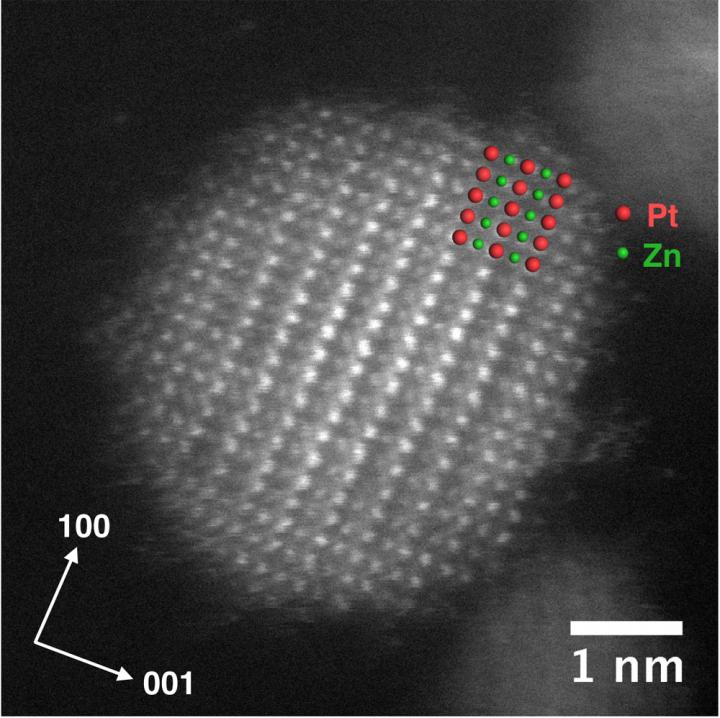Ames Laboratory and Iowa State University scientists develop more efficient catalytic material

This high-resolution image shows the distribution of platinum and zinc atoms in a PtZn intermetallic nanoparticle. Credit: Ames Laboratory, U.S. Department of Energy
The researchers succeeded by overcoming some of the technical challenges presented in the fabrication of the platinum-zinc nanoparticles with an ordered lattice structure, which function best at the small sizes in which the chemically reactive surface area is highest in proportion to the particle volume.
“That surface-to-volume ratio is important in getting the most out of an intermetallic nanoparticle,” said Wenyu Huang, Ames Laboratory scientist and assistant professor of Chemistry at Iowa State University. “The smaller the particle, the more surface there is, and more surface area increases the catalytic activity.”
But the high temperature of the annealing process necessary to form intermetallic nanoparticles often defeats the goal of achieving a small size.
“High-temperature annealing can cause the particles to aggregate or clump, and produces larger sizes of particles that have less available surface and aren't as reactive. So, just the steps necessary to produce them can defeat their ultimate chemical performance,” said Huang.
To prevent aggregation from occurring during the heating process, Huang's research group first used carbon nanotubes as a support for the PtZn nanoparticles, and then coated them with a sacrificial mesoporous silica shell for the high-temperature annealing to form the intermetallic structures. A chemical etching process then removes the silica shell afterward.
The resulting final product of uniform 3.2 nm platinum-zinc particles not only yielded twice the catalytic activity per surface site, that surface area saw ten times the catalytic activity of larger particles containing the same amount of platinum.
The discovery was made possible in part by the capabilities of a new Titan scanning electron microscope at Ames Laboratory's Sensitive Instrument Facility, jointly funded by the Department of Energy and Iowa State University.
“Being able to see the distributions of the material at atomic level with our new microscope has made an enormous positive impact on the Laboratory's capabilities to fine-tune materials,” said Lin Zhou, associate scientist and instrument lead for the Sensitive Instrument Facility. “It's a much more immediate process, being able to collaborate directly with the fabrication scientists in-house. Based on the results and suggestions we provide, they can improve the material, we can characterize it yet again, and the discovery cycle is much faster.”
###
The research is further discussed in a paper, “Sub-4 nm PtZn Intermetallic Nanoparticles for Enhanced Mass and Specific Activities in Catalytic Electrooxidation Reaction”, authored by Zhiyuan Qi, Chaoxian Xiao, Cong Liu, Tian-Wei Goh, Lin Zhou, Raghu Maligal-Ganesh, Yuchen Pei, Xinle Li, Larry A. Curtiss, and Wenyu Huang and published in the Journal of the American Chemical Society.
The work was funded by the National Science Foundation, Iowa State University, Ames Laboratory Directed Research and Development (LDRD) funds, and the U.S. Department of Energy's Office of Science. Computational work was supported by the Laboratory Computing Resource Center and the Center for Nanoscale Materials, both at Argonne National Laboratory.
Ames Laboratory is a U.S. Department of Energy Office of Science national laboratory operated by Iowa State University. Ames Laboratory creates innovative materials, technologies and energy solutions. We use our expertise, unique capabilities and interdisciplinary collaborations to solve global problems.
DOE's Office of Science is the single largest supporter of basic research in the physical sciences in the United States, and is working to address some of the most pressing challenges of our time. For more information, please visit science.energy.gov.
Media Contact
All latest news from the category: Materials Sciences
Materials management deals with the research, development, manufacturing and processing of raw and industrial materials. Key aspects here are biological and medical issues, which play an increasingly important role in this field.
innovations-report offers in-depth articles related to the development and application of materials and the structure and properties of new materials.
Newest articles

Combatting disruptive ‘noise’ in quantum communication
In a significant milestone for quantum communication technology, an experiment has demonstrated how networks can be leveraged to combat disruptive ‘noise’ in quantum communications. The international effort led by researchers…

Stretchable quantum dot display
Intrinsically stretchable quantum dot-based light-emitting diodes achieved record-breaking performance. A team of South Korean scientists led by Professor KIM Dae-Hyeong of the Center for Nanoparticle Research within the Institute for…

Internet can achieve quantum speed with light saved as sound
Researchers at the University of Copenhagen’s Niels Bohr Institute have developed a new way to create quantum memory: A small drum can store data sent with light in its sonic…





















